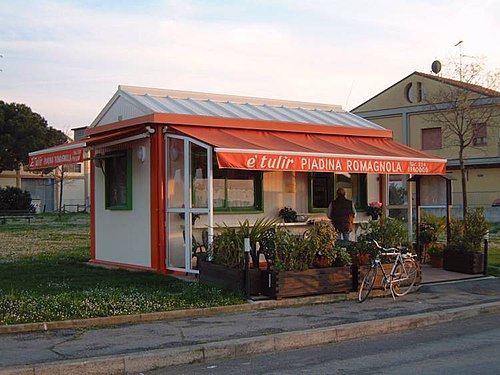This articleneeds additional citations forverification. Please helpimprove this article byadding citations to reliable sources. Unsourced material may be challenged and removed. Find sources: "Piadina romagnola" – news ·newspapers ·books ·scholar ·JSTOR(March 2017) (Learn how and when to remove this message) |
You can helpexpand this article with text translated fromthe corresponding article in Italian. (May 2025)Click [show] for important translation instructions.
|
 | |
| Alternative names | Piadina,piada |
|---|---|
| Type | Flatbread |
| Place of origin | Italy |
| Region or state | Romagna |
| Main ingredients | Flour,lard orolive oil, salt, water |
Piadina romagnola (Italian:[pjaˈdiːnaromaɲˈɲɔːla]) or simplypiadina, traditionallypiada (Italian:[ˈpjaːda];Romagnol:pièda), is a thinItalianflatbread, typically prepared in theRomagna historical region (which mostly consists of the Italian provinces ofForlì-Cesena,Ravenna, andRimini, and theRepublic of San Marino). It is usually made with white flour,lard orolive oil, salt, and water. The dough was traditionally cooked on a terracotta dish (locally calledteggia ortesto), although nowadays flat pans orelectric griddles are commonly used.
Piadina has been added to the list of theprodotti agroalimentari tradizionali (PAT) of theEmilia-Romagna region, and to theprotected geographical indication of theEuropean Union in 2014.[1]
Sinceancient Rome flatbreads like this were used, the first mention of thepiadina was in 1317,[2] in theDescriptio provinciæ Romandiolæ, whenpapal legateAngel de Grimoard describes its recipe: "It's made with grain wheat mixed with water and seasoned with salt. It can also be made with milk and seasoned with a bit of lard."
The etymology of the wordpiadina is uncertain; many think the termpiada (piê,pièda,pìda) was borrowed from theGreek word for 'focaccia'. Others think the term was borrowed from other languages because of the large use of similar foods throughout theEastern Roman Empire. The termpiada was officialised byGiovanni Pascoli, who adapted theRomagnol wordpiè into its more Italian form.[3]

Piadine are usually sold immediately after preparation in specialisedkiosks (calledpiadinerie), filled with a variety of cheeses,salumi, and vegetables, but also with sweet fillings, includingNutella or jam. There may be small differences depending on the zone of production.Piadine produced around Ravenna and Forlì are generally thicker, while those produced around Rimini and theMarche region are thinner and the diameter is greater.[citation needed]
Piadina has even found its way to space, eaten by a Russian astronaut as part of aMediterranean diet experiment on theInternational Space Station.[4]
| La j'è bona in tot i mud, la j'è bona énca scundida sa' n'avì ancora capì, a scor propri dla pida. | Delicious with filling or even served plain, if you haven't already guessed, I am talking about thepiadina. |
According toGiovanni Pascoli,
Nothing speaks more of Romagna than this bread of ours... it is a symbol that speaks of devotion to our land.
— Romagna Piadina: from tradition to flavour[3]